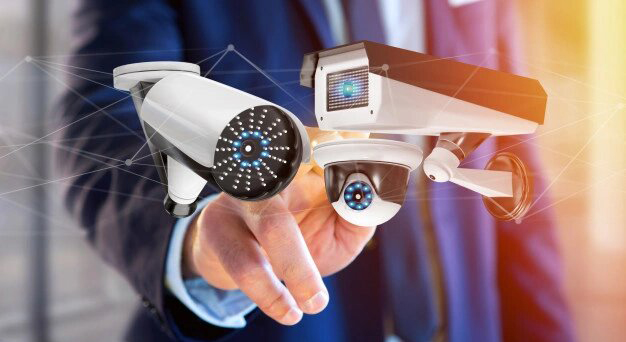It is very difficult to navigate the world of ever-changing and evolving technical articles today. This is exactly what surveillance cameras are like. In this menu item, we will try to help you make a decision. First of all, it is important to note that you choose the camera is always with the observation area and visual and light conditions keeping in mind. It is worth thinking about the decision well because it is very expensive fun to replace them later. In case, if you need any queries you can knock us.
Surveillance Camera Operation:
How does a surveillance camera work? The CCD (charge-coupled device) sensor detects a series of analog signals that the digital circuitry of the camera encodes into digital signals. Digital signal processing provides interference-free transmission and greater image fidelity. What is a CCD? Each of the state-of-the-art cameras is equipped with this semiconductor chip used as an image resolver. Its working principle is that it converts the transmitted light into electrical voltage based on intensity.
So to talk about a camera, we definitely need a digital signal conversion panel as well as a CCD. The changes follow… Color or Black and White? Basically, a CCD cannot detect colors. There are two ways to turn the signal you want to capture in color: – by using color filters – by determining the voltage values of the three basic colors (RGB). More than 99% of commercially available surveillance cameras are color. However, it is not always obvious that only that is appropriate in terms of recording. There are certain situations where the use of a black and white camera is also definitely beneficial.
Surveillance Camera Types:
As detailed in a previous article ( What you need to know! ), We basically distinguish three systems:
- Analog cameras (for DVR recorders)
- HD-TVI and Analog HD (AHD) cameras (for DVR recorders)
- IP cameras (for NVR or computer recording)
However, these differ mainly in the way they are recorded (with the exception of the IP camera, which already encodes and compresses the recordings on its own). So let’s see what kind of surveillance cameras are available in our offer:
-
Box Cameras:
Conventionally designed, medium to small, usually rectangular surveillance cameras. It was perhaps the most common type, as they first appeared on the market. It is characterized by the fact that they do not have optics at the factory, so we can mount them with almost any lens with a focal length and angle of view, which is also the main advantage (you can easily set what and how close you want to see). Only day & night versions are suitable for night recording on their own, their minimum light requirements vary by model. You can also install these cameras indoors and outdoors, but it is recommended to install them in a heated camera housing outdoors.
-
Dome Cameras:
It got its name from its shape (dome = dome). You can install it primarily on a ceiling, but in some cases can also be used on a sidewall. It is a very common type of camera, available in many versions with fixed or adjustable focus and zoom distances, usually with pre-installed lenses. There are also several versions in terms of night vision, it is also available in IR-led illumination and Day & Night versions. It ranges in size from extremely small to large. It is also available in vandal-proof housing, also in outdoor design.
-
Speed Dome Cameras:
Looks similar to the dome cameras detailed above, but the difference is their knowledge that speed dome cameras can be rotated and tilted remotely, so they can move X and Y axis and zoom (PTZ) and scan on a pre-programmed route. You can see this type of surveillance camera primarily in public areas and larger malls. We recommend it for use where staff are watching camera images and may require, for example, tracking a person or approaching a specific point at certain intervals. This type of camera is quite expensive because both the camera unit and the optics and mechanics are designed for heavy use. Available in both outdoor and indoor versions.
-
Bullet (Compact) Cameras:
It got its name from its size and shape. Manufacturers have built that into pre-designed outdoor or indoor housing as a common feature, elements such as optics are not replaceable. Recommended for general monitoring tasks. Its night vision is provided by IR LEDs in almost all available versions. They have a fixed or adjustable focus and zoom distance depending on the type. Today, it is perhaps the most common security surveillance camera version, due to its popularity mainly due to its price.
-
Hidden Cameras:
According to their name, they are extremely small panel cameras that can be hidden in objects of your choice or installed in prefabricated houses (smoke detector, motion detector, clock, mirror…). The number of options is almost limitless, ideally, a hidden camera can be made from anything thanks to pinhole lenses. In general, they can be said to be the most common versions with fixed optics, and some models also have a night vision function. Their use is subject to extremely strict regulations, if you are looking for such a solution, please contact us.
-
IR Cameras:
An unspoken surveillance camera type, as detailed above, its name refers to its ability to see at night. Also available in bullet (compact), dome, speed dome, low dome, concealed versions. As its name suggests (infrared) is their main feature, we are talking about a camera type equipped with night vision infrared illuminators. You can employ it both outdoors and indoors. Their night vision capability depends on the number of IR LEDs, usually ranging from 10 to 80 meters. Versions with third-generation (power) LEDs are also available in our offer.
-
IP Cameras:
Like the previous one, the name does not indicate the design of the camera, but it is important to say a special word about it. This camera is already a complete surveillance system in itself. When connected to our wired or wireless network, it is already able to transfer the recorded image to the Internet or our computer with the help of its internal software. Its widespread use is becoming more decisive today, and we can safely say that its popularity and knowledge will soon make it the number one security surveillance camera system of the future. Also available in a box, dome, speed dome, bullet, and hidden forms.
-
HD-TVI and AHD Cameras:
Its name covers the type of technology. A version of traditional old analog systems developed for HD quality. Imaging is provided by the recording unit (DVR), so depending on the quality and length of the cabling, there may be a significant loss of image quality. The advantage is that you can easily convert old (analog) systems to HD quality by replacing devices (cameras and recorders). And for small systems, it can be a more cost-effective solution than an IP camera system. Also available in a box, dome, speed dome, bullet, and hidden forms.
What are the Best CCTV Cameras for Security and Surveillance?
Below there are the 7 best CCTV cameras for your security and surveillance
- Dome Camera. The most popular camera for indoor surveillance that we regard actually as a fundamental security camera
- Bullet Camera
- C-mount Camera
- Day/Night CCTV Camera
- Infrared/Night Vision CCTV Camera
- Varifocal Cameras
- Wireless Cameras
Can CCTV Cameras Function without an Internet Connection?
Obviously, you can use CCTV cameras without being connected to the internet, and it is the most surprising matter is that they can even function in the absence of electricity. Yet, if you want to control it remotely, you may need an internet connection to get the footage accessed.
Conclusion
Finally, we can say that CCTV cameras have now become the constant companion of the people. By installing a CCTV camera people now can sleep peacefully. So, while buying CCTV cameras be aware of your needs and demands properly.





